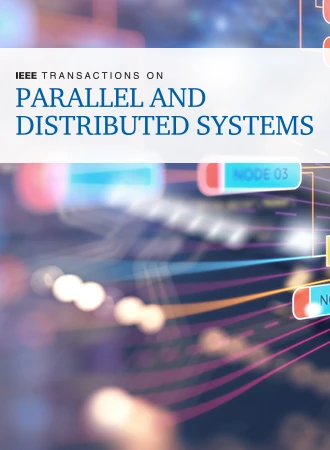FlexRaft:利用灵活的擦除编码实现最低成本共识和快速恢复
IF 5.6
2区 计算机科学
Q1 COMPUTER SCIENCE, THEORY & METHODS
IEEE Transactions on Parallel and Distributed Systems
Pub Date : 2024-08-14
DOI:10.1109/TPDS.2024.3443424
引用次数: 0
摘要
Paxos 和 Raft 等共识协议可为分布式服务提供数据一致性和容错性。这些协议中的日志复制可由擦除编码提供支持,擦除编码比全拷贝复制产生的冗余度更低,可显著节省网络和存储成本,从而提高整体性能。然而,采用擦除编码的现有共识协议无法在日志复制过程中实现最低的网络和存储成本。我们提出了 FlexRaft,它能根据服务器状态动态改变 Raft 中使用的编码方案,以始终达到理论上的最小冗余比,同时保持与 Raft 相同的有效性。为了解决领导者和跟随者之间编码方案不一致的问题,我们规定了覆盖日志条目的前提条件,并允许领导者和跟随者精确跟踪正在使用的编码方案。我们进一步将 FlexRaft 扩展为 FlexRaft+,它提供了不同的存储布局,通过一种称为无重码复制的新技术来改变编码方案,从而实现快速的服务器恢复。我们证明 FlexRaft 和 FlexRaft+ 都能保持 Raft 安全性。我们实现了 FlexRaft 和 FlexRaft+ 的原型,并在此基础上构建了分布式键值存储,以展示其功效。在阿里巴巴云上的实验表明,FlexRaft 实现了理论上最低的网络和存储成本,与最先进的 CRaft 和 HRaft 相比,提交延迟分别降低了 44.51% 和 19.37%。当编码方案发生变化时,FlexRaft+ 还能进一步降低提交延迟,并提高服务器恢复性能。本文章由计算机程序翻译,如有差异,请以英文原文为准。
FlexRaft: Exploiting Flexible Erasure Coding for Minimum-Cost Consensus and Fast Recovery
Consensus protocols like Paxos and Raft provide data consistency and fault tolerance for distributed services. Log replication in these protocols can be supported by erasure coding, which incurs lower redundancy than full-copy replication and significantly saves network and storage costs for overall performance improvements. However, existing consensus protocols with erasure coding cannot achieve the minimum network and storage costs during log replication. We propose FlexRaft, which dynamically varies the coding scheme used in Raft based on the server status to always achieve the theoretically minimum redundancy ratio, while maintaining the same liveness as in Raft. To address the issue of an inconsistent coding scheme between the leader and its followers, we specify the prerequisite of overwriting a log entry and also allow the leader and its followers to exactly track the coding scheme being used. We further extend FlexRaft into FlexRaft+, which provides a different storage layout to vary the coding scheme through a novel technique called re-encoding-free replication, so as to enable fast server recovery. We prove that both FlexRaft and FlexRaft+ maintain Raft safety. We implement a prototype of FlexRaft and FlexRaft+, atop which we build a distributed key-value store to show its efficacy. Experiments on Alibaba Cloud show that FlexRaft achieves the theoretically minimum network and storage costs in practice, and reduces the commit latency by 44.51% and 19.37% compared with state-of-the-art CRaft and HRaft, respectively. FlexRaft+ further reduces the commit latency when the coding scheme is being varied and improves the server recovery performance.
求助全文
通过发布文献求助,成功后即可免费获取论文全文。
去求助
来源期刊

IEEE Transactions on Parallel and Distributed Systems
工程技术-工程:电子与电气
CiteScore
11.00
自引率
9.40%
发文量
281
审稿时长
5.6 months
期刊介绍:
IEEE Transactions on Parallel and Distributed Systems (TPDS) is published monthly. It publishes a range of papers, comments on previously published papers, and survey articles that deal with the parallel and distributed systems research areas of current importance to our readers. Particular areas of interest include, but are not limited to:
a) Parallel and distributed algorithms, focusing on topics such as: models of computation; numerical, combinatorial, and data-intensive parallel algorithms, scalability of algorithms and data structures for parallel and distributed systems, communication and synchronization protocols, network algorithms, scheduling, and load balancing.
b) Applications of parallel and distributed computing, including computational and data-enabled science and engineering, big data applications, parallel crowd sourcing, large-scale social network analysis, management of big data, cloud and grid computing, scientific and biomedical applications, mobile computing, and cyber-physical systems.
c) Parallel and distributed architectures, including architectures for instruction-level and thread-level parallelism; design, analysis, implementation, fault resilience and performance measurements of multiple-processor systems; multicore processors, heterogeneous many-core systems; petascale and exascale systems designs; novel big data architectures; special purpose architectures, including graphics processors, signal processors, network processors, media accelerators, and other special purpose processors and accelerators; impact of technology on architecture; network and interconnect architectures; parallel I/O and storage systems; architecture of the memory hierarchy; power-efficient and green computing architectures; dependable architectures; and performance modeling and evaluation.
d) Parallel and distributed software, including parallel and multicore programming languages and compilers, runtime systems, operating systems, Internet computing and web services, resource management including green computing, middleware for grids, clouds, and data centers, libraries, performance modeling and evaluation, parallel programming paradigms, and programming environments and tools.
 求助内容:
求助内容: 应助结果提醒方式:
应助结果提醒方式:


